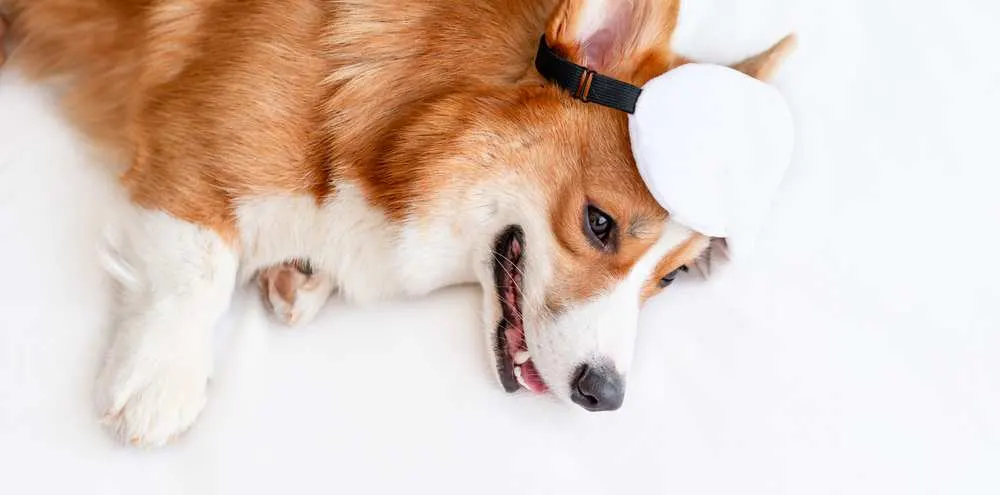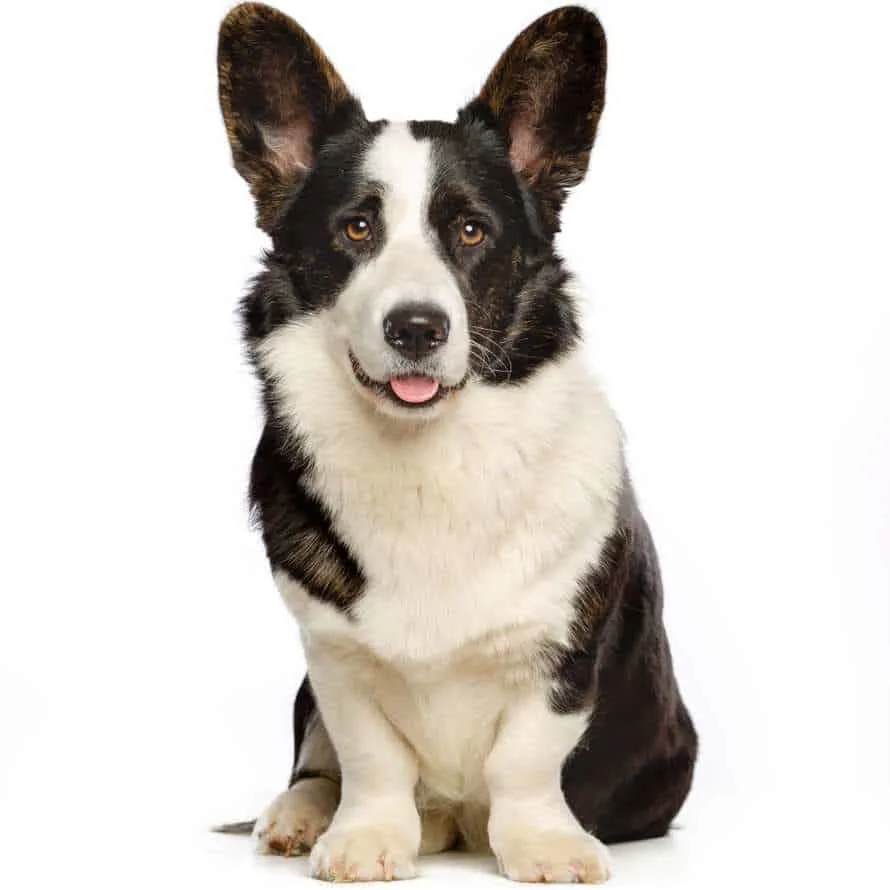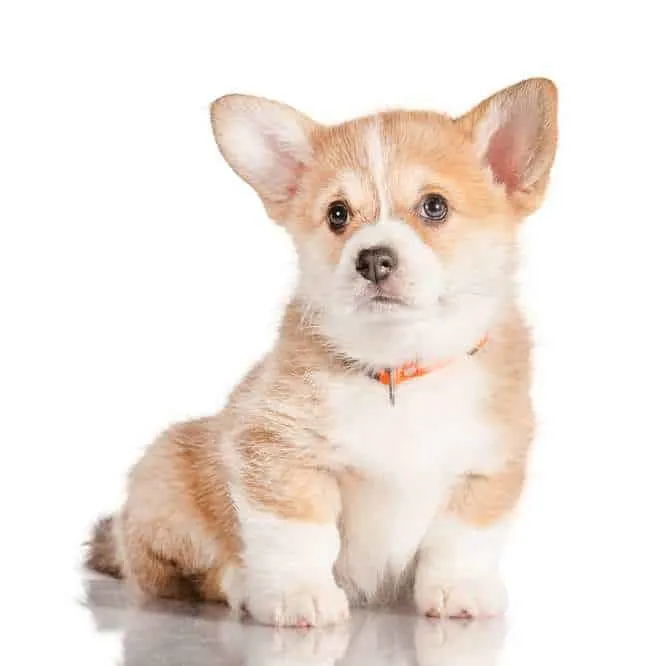If you were thinking about buying a dog for a loved one or for yourself in the recent future, then we encourage you to go and search for a corgi puppy. They are cute, loveable, and smart.
Being 100% sure of the choice you made is crucial. So, before going to buy one, you should know everything about corgi puppies – their health, temperament, lifespan, and even some tips for you as an owner. Becoming familiar with some of the necessary information about your future pet will be of tremendous help in the future.
Therefore, continue reading this article, and we will happily walk you through anything you could possibly ask about corgi puppies.

Corgi Puppies – Basic Info
Consider this a brief introduction to corgi puppies. Let’s begin by saying that they are adorable when they are still a baby, but this is not enough for you to take it home. You need some other reliable information, and here it is:
When you look at them, they are fluffy, small in size, and happy-looking. There are two types of corgi puppies:
- Cardigan Welsh Corgi Puppies– they are a little larger, and they have long tails. They can be brittle or blue merle.
- Pembroke Welsh Corgi Puppies– they are smaller and are blessed with a wide variety of coats – red, sable, tan, black, etc.
The lifespan depends on the type and their health in general.
In case you haven’t known, there is another subtype of corgi puppies known as a “cowboy corgi.” To be perfectly clear, this is a mixture of a corgi and an Australian cattle dog. They are also small in size, but this doesn’t stop them from being hyperactive all the time – this is something to consider before buying one.
Cowboy corgis are frequently recommended for families with children because of their obedience and performing qualities.
However, since they are a mixture of a corgi and Australian cattle dog, their appearance can differ from one puppy to another depending on the dominant gene. Nevertheless, they will undoubtedly warm your heart with cuteness.
This breed is perfect for a family that has love to give. And corgis will give love back – they are very loyal and protective of their owners.
Corgis are a susceptible breed, and they can get out of control quickly and easily – so, before it is too late, you should sign up for a training class. They can get frightened very quickly, which can cause many unwanted consequences, especially for the owner.
Whether you are adopting or buying a baby corgi, you should be acquainted with the rules and procedures this includes. It is like looking after a child in a way – you have to be responsible and rise to the challenge of taking care of someone.
Cardigan vs. Pembroke Welsh Corgi Puppies
As we mentioned at the beginning – there are two main types of this breed.
Let’s start by getting to know the Cardigan Welsh corgi:
For starters, Cardigan Welsh Corgis are one of the oldest breeds in Britain – meaning they have been around for more than 3000 years. Wow!
Some of them were affected by the Viking invasion about 1000 years ago. While some were mixed with a Splitz-type, others lived totally untouched by this and retained their original blood – hence the Cardigan Welsh Corgi we know and love today.
Despite their evident cuteness and appearance, they were not very favorable in the 1800s. This was actually when the first dog shows took part. It took some time before this breed came through. Cardigan Welsh Corgis gained their deserved recognition and popularity a hundred years ago – sometime in the 1920s.
In June 1932, the first Cardigan Welsh Corgi was welcomed into the USA. From that point on, they became very popular and have won numerous contests and championships.
It would also be essential to mention that they come from Cardiganshire in Wales – hence the name Cardigan Welsh Corgi, and therefore they can be considered somewhat a rougher terrain than the Pembroke Welsh Corgi.
In addition to this, they are a bit longer and more prominent, so they are close to being viewed as a “farm dog.” After you had them for a while, you will probably notice that they are a bit heavy and that they don’t have a very outgoing personality like the Pembroke breed. They are a bit more serious and an excellent addition to a small, conservative family.
Cardigan Welsh Corgis are the perfect dog for watching your child. These dogs will simply enjoy playing with your child throughout the entire day.
Although they are considered a small-sized dog, they have a “big dog” bark, which will definitely scare your intruder. But this bark will be something you will be listening to an awful lot if you don’t show them that you are the boss and the beginning. This is why early training is a must!
Let’s briefly mention the physical characteristics of a Cardigan Welsh corgi.
They are more prosperous and variable in color than the Pembroke breed. You can see a Cardigan Welsh corgi in red and white, sable and white, and many more.
They are very round and large in size with small legs with round feet and bones. They have a curved upper arm around the chest and straight pasterns.
Their head has a blunt wedge shape and they have full, long, fluffy tails.
As far as their personality is concerned, they are pretty much even-tempered dogs, which means that they can quickly adapt to any environment you put them in. This is a big plus for the breed!
Your Cardigan Welsh corgi is not immune to health problems. Throughout his life, he might have some issues with hip dysplasia, progressive retinal atrophy, degenerative myelopathy – but we will get to this in detail later. However, you can avoid the majority of this by being a responsible owner and taking your dog to the vet for regular checks – OFA or PennHip test for hip dysplasia, a genetic test to detect a PRA carrier, and a test that identifies the puppies that are at an increased risk of developing degenerative myelopathy.
If you keep your Cardigan Welsh corgi in good health and adequately take care of him, he will be around for 12-15 years, so good luck!
Some say that this breed can end up living for almost 18 years, but sadly this is not that frequent, and you must really be lucky if your corgi exceeded 15 years of life.
Now, let’s move on to the second type – the Pembroke Welsh corgi:
Unlike the Cardigan Welsh corgi, this type is not so easy to track down.The most reliable sources tell us that the Pembroke Welsh corgis originate from Wales, but there are numerous folk stories and beliefs that say otherwise.
One of the most popular ones and definitely worth mentioning is the connection between corgis and fairies. You might ask yourself – fairies? Yes, the legend says that they used to ride corgis into battle.
According to this legend, a pair of Pembroke Welsh corgis were gifted to two human children. They were given to them upon the Tylwyth Teg funeral, and they spoke of the numerous talents these dogs possessed. For example, they were great warriors and helpers of the fairies.
Then, we have the name “corgi” – “gi” meaning dog in Welsh and “cor” meaning dwarf. From that, we can draw a conclusion and meaning of the name – “dog of the dwarfs.” Sounds believable, right?
Many of the Pembroke Welsh corgis appear to have a darker patch of fur under their shoulders, which is also known as the “fairy saddle.” Some say that your corgi should not be fitted with collars that are made out of iron or steel because fairies are opposed to that kind of material.
This type’s life expectancy is a little shorter than the Cardigan Welsh corgi, with 12-13 years, and if you are the lucky one, they will live up to 16 years.
As far as appearance goes, they are medium-sized, and their head resembles a fox’s head. And the exciting thing to mention is they have distinct markings visible on each side of their withers (already mentioned in the fairy legend).
Their coat is good-looking, thick, even, and resistant to weather. This means that they can quickly adapt during every season. They come in fawn, black, white, red, or black. Unlike the Cardigan Welsh corgis, these corgis have a tiny tail or no tail at all.
These dogs have an outgoing personality but are as well as the Cardigan Welsh corgis, famous in families. They will definitely light up the room and bring positive energy and bring out the playfulness in all of us. Anyhow, a perfect addition! They are also very loyal to their owner and will try to please them.
They are a bit more energetic than the other corgi breed, and their owners tend to expose them to different people and sounds from an early age. Even if you have adopted a slightly older corgi who is in the process of changing homes, and he will have no problem in adapting to the new environment – so don’t worry about that!
One other thing – don’t be fooled by their cute ears and small size. This dog has a firm and loud bark, which will scare anyone who is trying to hurt you.
The aspect which is not promising when choosing this breed is their health. Pembroke Welsh corgis are prone to many health issues. They can suffer from hip dysplasia and degenerative myelopathy like the Cardigan breed, cataracts, cutaneous asthenia, cystinuria, epilepsy, retinal dysplasia, and the list goes on. So, before buying or adopting this breed, it is essential to check if they have any medical history that you should be aware of.
It would also be best if you asked for some medical clearances: health clearance from the Orthopedic Foundation for Animals, from Auburn University for thrombophilia, and from the Canine Eye Registry Foundation (CERF), which guarantees that your dog’s eyes are normal.
We have only scratched the surface with this introduction of the two breeds. There is a lot more behind these two cute pets that you should know, and we are going to explain each point in detail, so continue reading!
Read Also: 99 Best Names For Corgis – How To Name A Corgi?

How Much For A Corgi Puppy?
When buying any dog, not just corgi, an aspect that probably takes up the most is money. This is a very important factor, and you should first check your budget and become familiar with all of the expenses that come with this particular breed.
You shouldn’t engage in this if you don’t have enough money in your bank account. It would also be best if you didn’t let the seller trick you into paying more than it is worth. That is why you should look into how much does a corgi puppy cost and be smart with your money!
Dog prices can range from $400 to $4000 – there is no joke about that. And we, as people, frequently engage in bargaining and reaching for the lowest price. But at the end of the day, one thing is sure – you get what you paid for. And this can go both ways.
Strictly speaking, a corgi can cost you from $600 to $1000. The price depends on the breeder and the health of a dog. So, if your dog is in good health, it is likely that you will have to empty your pockets a bit more, but that is understandable.
Cardigan Welsh corgis are more expensive than the Pembroke Welsh corgis simply because they are rare, and this considerably adds to their value – some have been sold for $2000.
But, before bringing your corgi home and introducing it to the entire family, you will have to visit the vet and do some pre-checks. Bear in mind that these checks are not cheap at all, so be prepared.
It would be best to see it for yourself so that you don’t get shocked once the vet hands you the bill.
First, we have the average costs for health clearances:
- OFA cardiac: $100-$500
- Penn Hip OR OFA Hips and Elbows: $200-$800
- CERF(CARE) Eye Exams: $50
- Thyroid Clearance: $520
- General Genetic Screening: $160
When you have gone through with all of this, your wallet will be emptier by $2000.
As a prospective and cautious buyer, you should first interview your breeder and get to know him. By being curious, there is a high chance that you will prevent your dog from failing on any of these tests, and you will definitely save some money.
If you have been digging into this matter deeply enough, you are likely to spot something they call “a backyard breeder.” What is that?
This is a person who breeds the dogs, but not in the best way. This means that this person has very little or no knowledge at all, let alone experience with dogs. Unfortunately, many people give in and ignore the red flags.
Here are some of the signs that you are dealing with a backyard breeder:
- The dogs he owns appear to be in poor health.
- The dogs have no titles.
- There is no spraying or neutering of the dogs.
- They sell their puppies for extremely low prices.
- The breeder doesn’t have any questions for you. His main goal is just to sell the puppy.
If you have successfully avoided this, your seller will tell you something about the medical costs for your corgi.
Since they are prone to various health issues, you should get a regular yearly check for:
- Hip dysplasia: $1500-$2200
- Degenerative myelopathy: $2000-$4000
- Cardio myelopathy: $1500-$3500
- Progressive retinal atrophy: $1700-$2300
These medical checks do not depend on the breed. So, no matter if you own a Cardigan or a Pembroke corgi, you should get them checked once a year.
There is also the option for adopting your corgi. If this is the case, you should look for well-operating dog shelters around.
Now that we have done the math and shown you the numbers, the final calculation says that you should save up a minimum of $3500 before deciding to buy a corgi.
Of course, before any of this, sit down and evaluate the current situation in your home. You should be able to answer the following questions:
- Does my budget allow me to buy a dog?
- Is my home/apartment fit for a dog?
- Do I have the needed finances for a 10+ year commitment?
Think twice, and then go for your wallet.
No dog deserves nothing less than a comfortable life.

Cultural Symbol & Popularity
When it comes to both Cardigan and Pembroke Welsh corgis, they both have a rich history and have gained fame worldwide – especially with the royals.
Although we love our pets, we seem to lack knowledge about how they came to exist and where they come from. Being familiar with this kind of information undoubtedly broadens your horizon concerning both culture and history.
We can all agree that this has been a suppressed topic. And what better way to restore the curiosity of the owners of these adorable puppies than through interesting historical anecdotes and legends that were once very popular.
The Tale of the Cardigan Welsh Corgi begins long, long ago…
This type comes from the Teckel family of dogs, which are famous for breeding Dachshunds. A Cardigan Welsh corgi is an ancient species and is believed to have been around for more than 3000 years. Can you believe that? According to historians, these puppies were brought by Celtic tribes who migrated from central Europe and ended up in Wales. Hence the “Welsh” part in the name.
One of the first actions for which they were in charge was to clear the way by chasing off the intruders and enemies. Strange for such a small dog? Well, actually, no. They are “equipped” with a very loud and scary bark for a small puppy like themselves. Later on, they acted as a herder – being behind the master cattle. Because of his duties and training, this dog was known as a “cattle dog” – being rather a guardian than a pet.
After a quiet and peaceful period, the Vikings came, and they brought a Splitz-type dog. They mixed this dog with the Cardigan Welsh corgi, and that is how the Pembroke Welsh corgi came into existence – but we will get to that in a minute.
In the 1800s came the first dog shows, but unfortunately, the Corgi was not so successful as they hoped. It took quite a lot of time for this breed to come through – they gained recognition in the 1920s when the British Kennel Club first examined them. Luckily for them, they became attractive to the British and expanded to the United States in 1934.
Unlike the previous one, the Pembroke Welsh Corgi has a lot of folk stories in their pocket.
This corgi type does not have a traceable history, but it is full of exciting folk stories in which many people actually believe, so why not mention a few of them? Maybe you will believe in them too, once you hear them.
Before we begin with the storytelling, let’s explain the name – “corgi” – “gi” meaning dog in Welsh and “cor” meaning dwarf. From that, we can draw a conclusion and meaning of the name – “dog of the dwarfs.” Sounds believable, right?
Okay, now we are ready for a story.
Once upon a time, there were fairies who lived and wandered through the woods of Wales. After some time, they became tired of wandering around all the time and having to fly long distances, so they came up with a plan – the dwarf dog. They used them for traveling, and when they had nothing to do, they sent them to play with children. One day, as the King and Queen Fairy were riding their dwarf dogs, they became distracted by some farmers and fell off the dogs. By the time they got back up, the dwarf dogs were nowhere to be seen.
They ended up with some children who took them back to their village. Luckily the people living there fell in love with the dogs, gave them the name Corgi, and the rest is history.
There is no secret to the popularity the corgis gained in the last century, especially with the British royals. After a long time of trying to find their place in the world, they became a cultural symbol of one royal family in Great Britain.
Surely, you have seen Queen Elizabeth II surrounded by corgis in many of her public gatherings and pictures. It all started when King George VI introduced the first Corgi to young Elizabeth in 1933. His name was Dookie.
Shortly after that, the Queen got another corgi – Jane, but she died in 1944. She was struck by a car. Feeling sad for her daughter, King George surprised young Elizabeth with yet another corgi – Susan. Elizabeth loved this one so much that she brought with her to her honeymoon with Prince Philip.
According to some reports, the Queen possessed more than 30 Pembroke Welsh corgis, all of whom were descendants from the one and only – Susan.
Willow was her last descendant, and he died in 2002. From that point on, the Queen resigned from being a corgi owner.
Corgis were not just seen as the Queen’s dogs – they were in the movie industry. The last Corgi, Willow, co-starred in a sketch for the opening of the London Olympics.
How far can one dog go?

Good For Kids
Many people have been asking – are corgis suitable for kids? When choosing to buy a dog for your family and you have a kid, you should definitely take some time to think this through. You don’t want to bring home an aggressive and disloyal dog.
It has been proven that dogs have a very powerful influence on children as they are growing up, so this is why you should surprise them with the right breed!
Lucky for you, corgis are not good – they are great for kids.
And there is more than one reason for this, so let’s list them:
Corgis have high energy levels
According to a recent study, Corgi is among the 15 most active dog breeds out there. It would help if you had a lot of energy to keep up with this dog, which is where kids come in. They become excellent playmates – soulmates!
Corgi will need at least one hour of exercise on a daily basis.
Small dogs for small kids
Having both an energetic and a big dog might not be such a good idea for your child. That is why, a corgi is known as a “kid-sized” dog. And this is a perfect combination.
Corgis belong to the small dog category because of their height and weight. They weigh between 20 and 30 pounds, so even if they knock over your kid while playing, this is not such a big deal.
They are very affectionate
Corgis are a very loveable breed, and they crave your attention. If they are in the right home environment, they will love you and your kid unconditionally. As we mentioned earlier, they can quickly adapt to almost any environment.
Corgis love love, and they are natural with small children, especially babies.
All you have to do basically is prepare your home for this dog and welcome him into a loving environment. The best time to introduce a corgi to your kid is somewhere between 3 and 12 weeks in the puppy’s life – in that way, they can grow up together.
One more thing, you can invite other kids to play with him – no harm there.

Corgi Temperament
We can all agree that a dog’s temperament is one of the essential characteristics. It is extremely helpful to become familiar with the dog’s behavioral pattern before you decide to bring it home to your family and kids.
Today, we are going to deal with corgi temperament, and does it have more advantages or disadvantages? Well, this depends on what you are looking for in a dog.
Let’s start by discussing how corgis behave in general. They are very happy and playful for starters, but keeping up with this kind of energy can sometimes become a bit demanding. If you don’t challenge your corgi daily, he can become needy.
One crucial fact about these dogs is that they can be loyal to you, but only if you train them well and in time. If you don’t engage in some training early, things can get out of control pretty quickly. They can become very stubborn, and this is hard to deal with.
Your corgis can also become very territorial, and they won’t be afraid to make a scene in the park – so be careful! Apart from these small inconveniences, these dogs are not dangerous.
All in all, they don’t have a bad temper if you set the rules and show who is the boss from the very beginning. Be prepared for their bark, though – you will hear it a lot.

Weight And Health Statistics
Having this type of information in front of you will definitely come in handy when you are on your way to a regular vet appointment for example.
Of course, we are not able to give you 100% precise data because every corgi is special and unique, but we are pretty close to average.
Let’s start by examining the Cardigan Welsh Corgi First:
| Males | Females | |
|---|---|---|
| Height: | 11-13 inches | 10-12 inches |
| Weight: | 38 pounds | 33 pounds |
And now, The Pembroke Welsh Corgi:
| Males | Females | |
|---|---|---|
| Height: | 10-12 inches | 9-11 inches |
| Weight: | 30 pounds | 25 pounds |
We can see from this that the Pembroke is a bit smaller in both size and weight.
No matter which corgi you own – you should know that weight matters.
Corgis love to eat, and they can consume a lot of food. Everyone is saying that there is nothing cuter than a small and chubby corgi. But this is not something you should cling to.
Offering your corgi a bowl full of food and not being able to resist cute doggy eyes every time you are having a snack will not contribute to your dog’s health at all.
From the table above, we can see that they are not that big, and that is precisely why they shouldn’t be fed over the limit. It’s hard carrying all that weight.
So, in order to keep your dog healthy, you should keep them on average weight, and you can do this by checking the ideal body score:
- Try to feel his ribs with your hands
- If you have a hard time counting them, then your corgi is overweight.
- If you can feel his ribs and they are sharp, your corgi is underweight.
An ideal body score is 4-5 on a scale of 9.
No dog is entirely immune to health issues, and corgi puppies have a few.
Let’s start with obesity. This is the most common health issue corgi dogs suffer from. As we know from earlier, corgis tend to eat – a lot. They will munch on everything they can find, and sometimes owners contribute to this by sharing their meal.
This is not a good idea at all. Although they are cute when they are chubby, obesity is a hazardous health condition, and it can trigger many more – like heart problems. The smartest thing to do would be to go to the vet and put together a safe diet for your pet.
Another health issue would be hip dysplasia. We have already mentioned it before, so you should be aware of this.
Unfortunately, this is an inherited condition that affects the dog’s hip joints on both sides. An X-ray can determine this, and the symptoms for this health condition are canine arthritis – this means that your dog is struggling with walking, and he is showing discomfort.
You should never breed a dog with hip dysplasia, and to be sure that you are not taking home one, the dog breeder should show you proper medical documentation.
Although this is mainly an inheritable disease, corgi dogs can develop it throughout their lives.
Another health issue is severe eye conditions like cataracts, progressive retinal atrophy, and retinal dysplasia. Let’s quickly go through them all.
Cataracts develop later in a corgi’s life, and they can be treated or surgically removed. This is also something for which your dog breeder should show you documentation.
Progressive retinal atrophy means that your corgi will be night-blind, and there is a chance that they might lose their day disease if it progresses fast.
Lastly, retinal dysplasia causes complete blindness.
Another disease your corgi might suffer from is Von Willebrand disease. This is a disease that prevents the dog’s blood from clotting. This disease is common between the ages of 3 and 5. It is similar to hemophilia, and you can notice it if your dog often has nosebleeds or a bloody stool.
Degenerative myelopathy (DM) is a very dangerous disease, and it occurs in the corgi’s spinal cord. The characteristics are weakness and sometimes even paralysis in the hind limbs. Since this is very common, your dog breeder should test the corgi in advance.
Corgis can also be victims of canine epilepsy, which is a severe neurological condition that is also inheritable. A corgi with canine epilepsy will have short seizures that can be pretty scary to watch. If this is the case, take your corgi to the vet immediately to see what triggers it.
Learn More: How Much Food To Feed A Corgi Puppy?

The Lifespan Of A Corgi
Surely, you have been wondering for how long a corgi will be in your life. While some search for answers, others refuse to know because it will probably make them sad.
This is for those who are curious about the life expectancy of a corgi.
Corgis will be in your life for approximately 12-15 years.
However, there are a lot of factors that influence this: size, health, and inbreeding issues.
While medium corgis live from 10-13 years, small corgis can live up to 15 years if you are lucky.
Inbreeding and health issues considerably reduce a corgi’s life – inbred dogs are more prone to genetic disorders.

Tips For Corgi Owners
So far, we have mentioned everything there is about corgi dogs, and if you have made up your mind to buy one, you will need some starter tips.
Don’t worry because we have got that covered as well.
Here are some essential tips for new corgi owners.
Before buying a corgi, you should definitely do some research. You can start by going online and visiting The American Kennel Club for useful information. It would be best if you never bought a corgi from a pet store instead of searching for an appropriate breeder.
Here are some questions you should ask him:
- What health tests has he done?
- What is the vetting process?
- Do they have a warranty for the puppies?
- Can you meet the puppies before buying them?
Make sure that your new corgi fits in your family life. Ensure that you are 100% ready for such a commitment and that the other family members are okay with getting a dog.
You should buy some necessary things for the puppy before you bring him home. These essentials include a crate, puppy food, food and a water bowl, pee pads, toys, and a dog bed.
You should train your corgi from an early age. Make him understand some basic commands. This might take some time, but you have to be patient and positive!

Corgi Puppies
There are two types of corgi puppies. The first are Cardigan Welsh corgi puppies – they are a little larger, and they have long tails. They can be brittle or blue merle. The second are Pembroke Welsh corgi puppies– they are smaller and are blessed with a wide variety of coats – red, sable, tan, black, etc.
This breed is very loveable and perfect for a family that has love to give. And corgis will give back – they are very loyal and protective of their owners.
Cardigan Welsh Corgis are one of the oldest breeds in Britain – meaning they have been around for more than 3000 years. Pembroke Welsh Corgis are not so easy to track down.The most reliable sources tell us that the Pembroke Welsh corgis originate from Wales, but there are numerous folk stories and beliefs that say otherwise.
Strictly speaking, a corgi can cost you from $600 to $1000. The price depends on the breeder and the health of a dog. So, if your dog is in good health, it is likely that you will have to empty your pockets a bit more, but that is understandable. As a prospective and cautious buyer, you should first interview your breeder and get to know him. By being curious, there is a high chance that you will prevent your dog from failing any of these tests, and you will definitely save some money.
It took quite a lot of time for this breed to come through – they gained recognition in the 1920s when the British Kennel Club first examined them. Luckily for them, they became attractive to the British and expanded to the United States in 1934. They were adored by the English Queen and some say that she owned more than 30 corgis.
Weight and height depend on the type of corgi. Males weigh between 30-38 pounds and are 10-13 inches high. With females, it’s a little different – their weight ranges from 25 to 33 pounds and they can reach 12 inches in height. Corgis will be in your life for approximately 12-15 years.
If you are buying a corgi for the first time, you should take into consideration some of the following tips: do some research, get to know the breeder, buy necessary dog equipment and train your corgi from an early age.
Keep calm, and corgi on!
Learn More: How Long Do Corgis Take To Grow? Growth & Weight Chart



